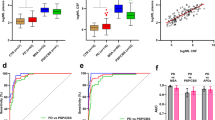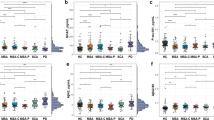Abstract
Purpose
There is a critical need for reliable diagnostic biomarkers as well as surrogate markers of disease progression in multiple system atrophy (MSA). Neurofilament light chain (NfL) has been reported to potentially meet those needs. We therefore sought to explore the value of NfL in plasma (NfL-p) in contrast to cerebrospinal fluid (NfL-c) as a diagnostic marker of MSA, and to assess NfL-p and NfL-c as markers of clinical disease progression.
Methods
Well-characterized patients with early MSA (n = 32), Parkinson’s disease (PD; n = 21), and matched controls (CON; n = 15) were enrolled in a prospective, longitudinal study of synucleinopathies with serial annual evaluations. NfL was measured using a high-sensitivity immunoassay, and findings were assessed by disease category and relationship with clinical measures of disease progression.
Results
Measurements of NfL-c were highly reproducible across immunoassay platforms (Pearson, r = 0.99), while correlation between NfL-c and -p was only moderate (r = 0.66). NfL was significantly higher in MSA compared with CON and PD; the separation was essentially perfect for NfL-c, but there was overlap, particularly with PD, for NfL-p. While clinical measures of disease severity progressively increased over time, NfL-c and -p remained at stable elevated levels within subjects across serial measurements. Neither change in NfL nor baseline NfL were significantly associated with changes in clinical markers of disease severity.
Conclusions
These findings confirm NfL-c as a faithful diagnostic marker of MSA, while NfL-p showed less robust diagnostic value. The significant NfL elevation in MSA was found to be remarkably stable over time and was not predictive of clinical disease progression.





Similar content being viewed by others
References
Boeve BF, Silber MH, Ferman TJ et al (2001) Association of REM sleep behavior disorder and neurodegenerative disease may reflect an underlying synucleinopathy. Mov Disord 16:622–630
Coon EA, Singer W (2020) Synucleinopathies. Continuum (Minneap Minn) 26(1):72–92
Stankovic I, Fanciulli A, Sidoroff V, Wenning GK (2022) A review on the clinical diagnosis of multiple system atrophy. Cerebellum. https://doi.org/10.1007/s12311-022-01453-w
Coon EA, Suarez MD, Ahlskog JE et al (2014) Survival in multiple system atrophy—insights from a large retrospective cohort. Ann Neurol 76:S39 (abstract)
Low PA, Reich SG, Jankovic J et al (2015) Natural history of multiple system atrophy in the USA: a prospective cohort study. Lancet Neurol 14:710–719
Wenning GK, Geser F, Krismer F et al (2013) The natural history of multiple system atrophy: a prospective European cohort study. Lancet Neurol 12:264–274
Hughes AJ, Daniel SE, Ben-Shlomo Y, Lees AJ (2002) The accuracy of diagnosis of parkinsonian syndromes in a specialist movement disorder service. Brain 125(Pt 4):861–870
Koga S, Aoki N, Uitti RJ et al (2015) When DLB, PD, and PSP masquerade as MSA: an autopsy study of 134 patients. Neurology 85:404–412
Osaki Y, Wenning GK, Daniel SE et al (2002) Do published criteria improve clinical diagnostic accuracy in multiple system atrophy? Neurology 59:1486–1491
Papp MI, Kahn JE, Lantos PL (1989) Glial cytoplasmic inclusions in the CNS of patients with multiple system atrophy (striatonigral degeneration, olivopontocerebellar atrophy and Shy-Drager syndrome). J Neurol Sci 94:79–100
Trojanowski JQ, Revesz T (2007) Proposed neuropathological criteria for the post mortem diagnosis of multiple system atrophy. Neuropathol Appl Neurobiol 33:615–620
Poggiolini I, Gupta V, Lawton M et al (2022) Diagnostic value of cerebrospinal fluid alpha-synuclein seed quantification in synucleinopathies. Brain 145:584–595
Rossi M, Candelise N, Baiardi S et al (2020) Ultrasensitive RT-QuIC assay with high sensitivity and specificity for Lewy body-associated synucleinopathies. Acta Neuropathol 140:49–62
Shahnawaz M, Mukherjee A, Pritzkow S et al (2020) Discriminating alpha-synuclein strains in Parkinson’s disease and multiple system atrophy. Nature 578:273–277
Singer W, Schmeichel AM, Shahnawaz M et al (2020) Alpha-synuclein oligomers and neurofilament light chain in spinal fluid differentiate multiple system atrophy from Lewy body synucleinopathies. Ann Neurol 88:503–512
Martinez-Valbuena I, Visanji NP, Kim A et al (2022) Alpha-synuclein seeding shows a wide heterogeneity in multiple system atrophy. Transl Neurodegener 11:7
Abdo WF, Bloem BR, Van Geel WJ et al (2007) CSF neurofilament light chain and tau differentiate multiple system atrophy from Parkinson’s disease. Neurobiol Aging 28:742–747
Hall S, Ohrfelt A, Constantinescu R et al (2012) Accuracy of a panel of 5 cerebrospinal fluid biomarkers in the differential diagnosis of patients with dementia and/or parkinsonian disorders. Arch Neurol 69:1445–1452
Wang SY, Chen W, Xu W et al (2019) Neurofilament light chain in cerebrospinal fluid and blood as a biomarker for neurodegenerative diseases: a systematic review and meta-analysis. J Alzheimers Dis 72:1353–1361
Chelban V, Nikram E, Perez-Soriano A et al (2022) Neurofilament light levels predict clinical progression and death in multiple system atrophy. Brain 145:4398–4408
Zhang L, Cao B, Hou Y et al (2022) Neurofilament light chain predicts disease severity and progression in multiple system atrophy. Mov Disord 37:421–426
Foubert-Samier A, Pavy-Le Traon A, Saulnier T et al (2022) An item response theory analysis of the unified multiple system atrophy rating scale. Parkinsonism Relat Disord 94:40–44
Krismer F, Palma JA, Calandra-Buonaura G et al (2022) The unified multiple system atrophy rating scale: status, critique, and recommendations. Mov Disord 37:2336–2341
Palma JA, Vernetti PM, Perez MA et al (2021) Limitations of the unified multiple system atrophy rating scale as outcome measure for clinical trials and a roadmap for improvement. Clin Auton Res 31:157–164
Dreger M, Steinbach R, Gaur N et al (2021) Cerebrospinal fluid neurofilament light chain (NfL) predicts disease aggressiveness in amyotrophic lateral sclerosis: an application of the D50 disease progression model. Front Neurosci 15:651651
Mattsson N, Cullen NC, Andreasson U et al (2019) Association between longitudinal plasma neurofilament light and neurodegeneration in patients with Alzheimer disease. JAMA Neurol 76:791–799
Rojas JC, Wang P, Staffaroni AM et al (2021) Plasma neurofilament light for prediction of disease progression in familial frontotemporal lobar degeneration. Neurology 96:e2296–e2312
Gilman S, Wenning GK, Low PA et al (2008) Second consensus conference on the diagnosis of multiple system atrophy. Neurology 71:670–676
Wenning GK, Tison F, Seppi K et al (2004) Development and validation of the unified multiple system atrophy rating scale (UMSARS). Mov Disord 19:1391–1402
Low PA (1993) Composite autonomic scoring scale for laboratory quantification of generalized autonomic failure. Mayo Clin Proc 68:748–752
Fealey RD, Low PA, Thomas JE (1989) Thermoregulatory sweating abnormalities in diabetes mellitus. Mayo Clin Proc 64:617–628
Lipp A, Sandroni P, Ahlskog JE et al (2009) Prospective differentiation of multiple system atrophy from Parkinson disease, with and without autonomic failure. Arch Neurol 66:742–750
Wenning GK, Stankovic I, Vignatelli L et al (2022) The movement disorder society criteria for the diagnosis of multiple system atrophy. Mov Disord 37:1131–1148
Singer W, Low PA (2015) Optimizing clinical trial design for multiple system atrophy: lessons from the rifampicin study. Clin Auton Res 25:47–52
Bagnato S, Grimaldi LME, Di Raimondo G et al (2017) Prolonged cerebrospinal fluid neurofilament light chain increase in patients with post-traumatic disorders of consciousness. J Neurotrauma 34:2475–2479
Varhaug KN, Torkildsen O, Myhr KM, Vedeler CA (2019) Neurofilament light chain as a biomarker in multiple sclerosis. Front Neurol 10:338
Singer W, Schmeichel AM, Shahnawaz M et al (2021) Alpha-synuclein oligomers and neurofilament light chain predict phenoconversion of pure autonomic failure. Ann Neurol 89:1212–1220
Kuhle J, Plavina T, Barro C et al (2020) Neurofilament light levels are associated with long-term outcomes in multiple sclerosis. Mult Scler 26:1691–1699
Palleis C, Morenas-Rodriguez E, Murcia FJM et al (2020) Longitudinal correlation between neurofilament light chain and UMSARS in multiple system atrophy. Clin Neurol Neurosurg 195:105924
Song SK, Lee SK, Lee JJ et al (2011) Blood-brain barrier impairment is functionally correlated with clinical severity in patients of multiple system atrophy. Neurobiol Aging 32:2183–2189
Amaador K, Wieske L, Koel-Simmelink MJA et al (2022) Serum neurofilament light chain, contactin-1 and complement activation in anti-MAG IgM paraprotein-related peripheral neuropathy. J Neurol 269:3700–3705
Huehnchen P, Schinke C, Bangemann N et al (2022) Neurofilament proteins as a potential biomarker in chemotherapy-induced polyneuropathy. JCI Insight 7:e154395
Hansson O, Janelidze S, Hall S et al (2017) Blood-based NfL: a biomarker for differential diagnosis of parkinsonian disorder. Neurology 88:930–937
Acknowledgements
This publication was made possible by the National Institutes of Health (NIH; R01 NS092625, U19 AG71754, UL1 TR000135), the Food and Drug Administration (FDA) (R01 FD07290), grants from the Michael J. Fox Foundation for Parkinson’s Research, Sturm Foundation, Bishop Dr. Karl Golser Foundation, Mayo Center of Regenerative Medicine, and Mayo Funds. Its contents are solely the responsibility of the authors and do not necessarily represent the official view of NIH or FDA.
Funding
NIH, FDA, grants from the Michael J. Fox Foundation for Parkinson’s disease, Sturm Foundation, Bishop Dr. Karl Golser Foundation, Mayo Center of Regenerative Medicine, and Mayo Funds.
Author information
Authors and Affiliations
Contributions
WS and PL contributed to the conception and design of the study. WS, AS, DS, TG, JG, MS, JA, PB, and TL contributed to the acquisition and analysis of data. WS and DS contributed to drafting the text and preparing the figures.
Corresponding author
Ethics declarations
Conflict of interest
None.
Rights and permissions
Springer Nature or its licensor (e.g. a society or other partner) holds exclusive rights to this article under a publishing agreement with the author(s) or other rightsholder(s); author self-archiving of the accepted manuscript version of this article is solely governed by the terms of such publishing agreement and applicable law.
About this article
Cite this article
Singer, W., Schmeichel, A.M., Sletten, D.M. et al. Neurofilament light chain in spinal fluid and plasma in multiple system atrophy: a prospective, longitudinal biomarker study. Clin Auton Res 33, 635–645 (2023). https://doi.org/10.1007/s10286-023-00974-6
Received:
Accepted:
Published:
Issue Date:
DOI: https://doi.org/10.1007/s10286-023-00974-6




